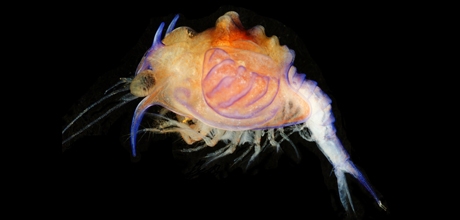GW Biology Professor Keith Crandall solves an oceanic mystery, linking “monster larva” to its adult counterpart.
A George Washington University biology professor has solved a nearly 200-year-old oceanic mystery, linking the “monster larva” found in the guts of fish to its adult counterpart.
In a study published in the journal “Ecology and Evolution,” GW Biology Professor Keith Crandall cracked the genetic code of Cerataspis monstrosa and discovered it is the younger version of a deep-water aristeid shrimp known as Plesiopenaeus armatus—the two are of the same species.
Such discoveries are important because they help researchers understand biodiversity and the life history, distribution and ecology of an organism, said Dr. Crandall, who was recently named founding director of the GW Computational Biology Institute.
“It’s very exciting to have solved a nearly 200-year-old conundrum,” Dr. Crandall said, adding that the discovery was largely thanks to good luck obtaining a sample, the use of state-of-the-art molecular and analytical tools and a large database of DNA to compare the larva to.
But it wasn’t easy, namely because the two bear no outward resemblance to each other. C. monstrosa has heavy armor, a thick body and horn ornamentation, while the Plesiopenaeus looks like a lobster or crab with a red, enclosed exterior. While researchers have suspected a link between C. monstrosa and some deep-sea shrimp since the late 19th century, they hadn’t been able to make the connection.
The National Science Foundation, the Gulf of Mexico Research Initiative and the National Oceanic and Atmospheric Administration supported Dr. Crandall’s research.


